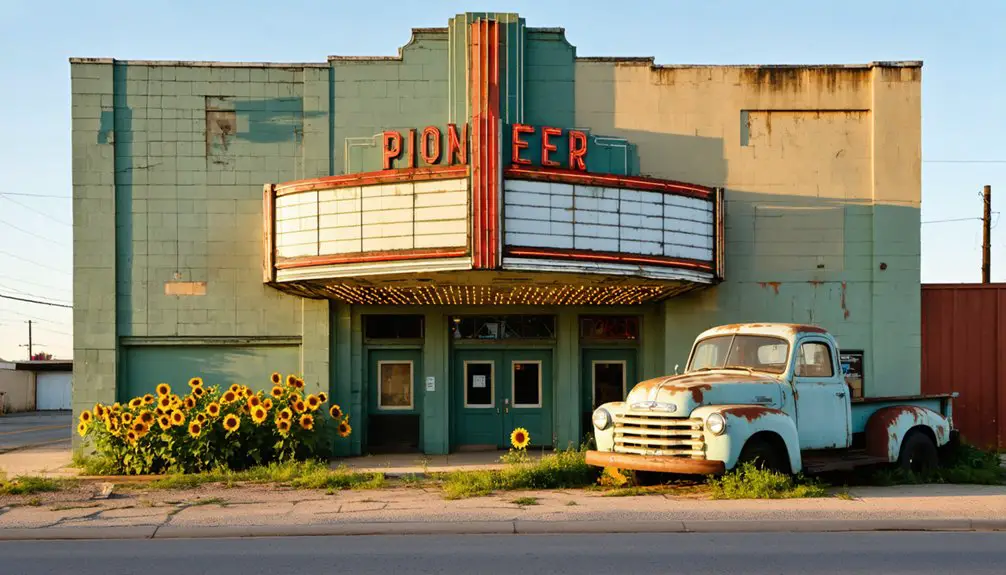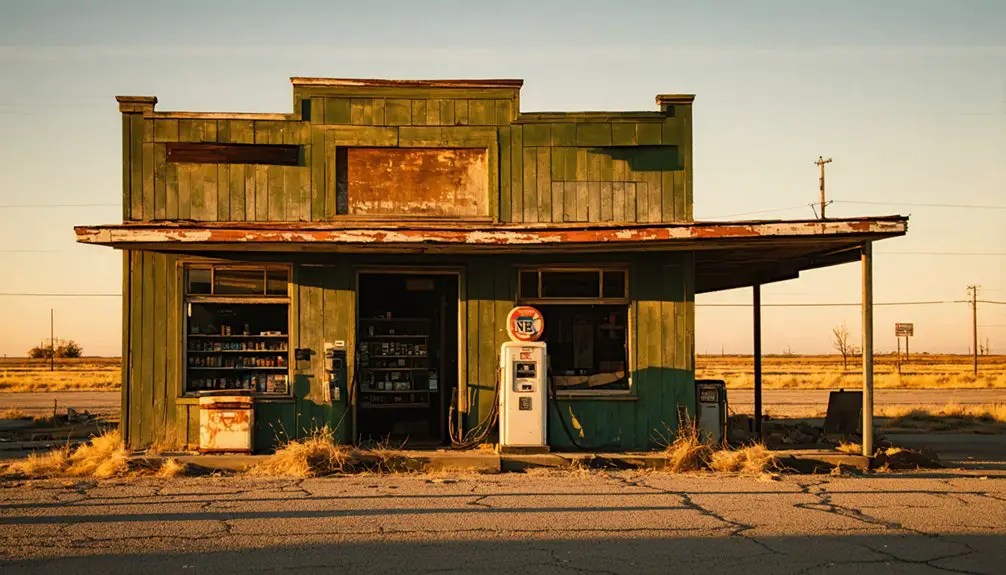You’ll discover Shamrock, Oklahoma at a historic crossroads where cattle trails once crossed. Founded in 1908, this Irish-named settlement exploded into a bustling oil boomtown by 1915, with its population soaring to 15,000 as daily oil production reached 300,000 barrels. When the wells ran dry in the mid-1920s, Shamrock’s fortunes faded. Today, fewer than 200 residents preserve the town’s rich heritage, where empty streets whisper tales of bygone glory.
Key Takeaways
- Shamrock, Oklahoma transformed from a bustling oil boomtown of 15,000 residents in 1915 to a near ghost town today with 100-200 inhabitants.
- The town’s decline began in the mid-1920s when oil production dwindled, causing mass exodus and business closures by 1930.
- Despite ghost town status, community spirit remains active through weekly Baptist Church youth gatherings and annual St. Patrick’s Day celebrations.
- Historical preservation continues through the Shamrock Museum, established in 1999, which houses local artifacts and photographs.
- Local volunteers, including religious leaders and fire department personnel, lead efforts to maintain the town’s cultural heritage and historical significance.
The Birth of an Irish-Named Settlement
The humble origins of Shamrock, Oklahoma trace back to 1908 when J.M. Thomas moved to this crossroads of cattle and wagon trails, establishing a store at what was likely the West Shawnee Trail. The name reflects the historical significance of the shamrock as a symbol of Irish identity since the late 16th century.
You’ll find the settlement origins were modest – Thomas became the first postmaster in 1910, naming the town after his hometown of Shamrock, Illinois.
By 1913, the small farming community had grown to include two general stores and a restaurant with a population of 35 residents.
From Farming Hamlet to Oil Boom Town
While J.M. Thomas first established his store in 1908, you wouldn’t have recognized the quiet farming hamlet Shamrock would soon become.
From modest country store to bustling boomtown, Shamrock’s humble origins gave no hint of its remarkable destiny.
Beyond traditional farming techniques, the town’s first economic impact came from Oklahoma Natural Gas pipeline workers who brought fresh money and energy to the crossroads settlement.
You’d have witnessed a dramatic transformation after 1915 when two major railways connected Shamrock to the booming Cushing-Drumright oil fields.
The town exploded with activity as businesses relocated near the tracks, and Tipperary Road became the hub of commerce.
Oil production reached a staggering 300,000 barrels daily, and Shamrock’s population swelled to 15,000.
The once-peaceful farming community transformed into a wild boomtown, complete with gambling halls and saloons where oilmen struck it rich and colorful characters like Ruby Darby entertained the masses. The local cotton gin processed over two dozen wagons of cotton each day, showing the town’s agricultural roots remained strong even during the oil boom.
Railroad Connections Shape Growth
During Shamrock’s meteoric rise, two major railways revolutionized the town’s destiny in 1915-1916. The Sapulpa & Oil Fields Railroad connected Depew to Shamrock, while the Atchison, Topeka and Santa Fe Railway linked Shamrock to Drumright, creating a crucial transportation network that would transform this farming hamlet forever. Like the famous rose of England, the shamrock had become a powerful symbol of identity by this time.
The railroad impact proved so significant that you’d have witnessed an entire town literally pick up and move. When the Sapulpa & Oil Fields Railroad bypassed Shamrock by three-quarters of a mile, determined citizens and business owners relocated closer to the tracks. By 1916, the bustling community boasted two newspapers and thirty buildings.
The economic transformation was dramatic – streets like Tipperary Road sprang up alongside the rails, and the town flourished as a bustling shipping hub for oilfield equipment and crude oil. Irish-themed street names and the depot’s shamrock emblem celebrated the town’s unique identity.
Peak Years of Prosperity and Wild Tales
From a modest farming settlement of 35 residents in 1913, Shamrock exploded into a raucous boomtown of 10,000 people after oil transformed its destiny.
You’d have found a town pulsing with saloons, gambling halls, and brothels, where oil legends Tom Slick and Harry Sinclair raced horses down Main Street after a night of drinking.
Ghost tales and colorful characters defined Shamrock’s wild years. At the Big Six gambling hall, a one-legged fiddle player kept order by wielding his wooden leg as a weapon.
Even notorious outlaw Pretty Boy Floyd left his mark, robbing a local bank in 1932. The town’s population swelled to as many as 25,000 during peak times, with oilfield camps bearing playful names like Dropright, Gasright, and Justright dotting the landscape. The town once had seven busy lumberyards to supply wood for the countless oil derricks being constructed.
The Green Heart of Oklahoma
You’d recognize old Shamrock instantly by its distinctive green-painted buildings adorned with shamrocks, earning it the nickname “The Green Heart of Oklahoma.”
From the emerald-hued railroad depot to streets bearing names like Tipperary and Dublin, the town embraced its Irish identity with remarkable commitment.
During the oil boom’s peak, this Irish-themed aesthetic set Shamrock apart from other boomtowns, as the community proudly displayed its Blarney stone and celebrated its heritage through local establishments like the Shamrock Brogue newspaper. The town’s population reached an impressive over ten thousand residents during the height of the Cushing Oil Field development.
Irish Pride Runs Deep
The vibrant heart of Shamrock beat with unmistakable Irish pride from its earliest days, when James M. Thomas established the town’s first post office in 1910.
You’d have found yourself walking down Tipperary Road, the main street named after the famous Irish ballad, or strolling past buildings painted in Ireland’s signature green and white trim.
The town’s Irish folklore and cultural traditions ran deeper than mere aesthetics. Streets bore names like Dublin, Killarney, and Cork, while the local newspaper, the Shamrock Brogue, kept the Celtic spirit alive. Today, the town still celebrates its heritage with a massive St. Patrick’s Day Celebration that draws visitors from across the region.
Even at the railroad depot, a proud shamrock symbol watched over travelers. During the oil boom, when the population swelled to 25,000, you’d have encountered lively saloons, gambling halls, and colorful characters who made this Irish-themed boomtown their home.
Oil Boom Glory Days
While Irish culture shaped Shamrock’s identity, black gold transformed its destiny.
You’d have witnessed an explosive economic transformation as the Cushing Oil Field gushed 300,000 barrels daily by 1915, making this region the “pipeline crossroads of the world.” The population surged to 15,000 as oilfield culture took hold, bringing a wild mix of saloons, gambling halls, and bustling commerce.
You’d have seen wealthy oilmen racing horses down Main Street while Ruby Darby entertained in packed venues. The town’s prosperity drew railroads, though they strategically bypassed Shamrock by three-quarters of a mile.
The boom created a thriving shipping hub for crude oil and equipment, while streets with names like Tipperary and Dublin reminded everyone of the town’s Irish roots amidst the oil-fueled frenzy.
St. Patrick’s Day Legacy Through Time
You’ll find that Shamrock’s St. Patrick’s Day legacy began impressively in 1916, when the town’s first parade drew 5,000 attendees during the height of the oil boom.
Though the town’s population has dwindled to around 200 residents today, the celebration continues as a cherished annual fundraiser for the volunteer fire department.
The event’s endurance reflects how deeply the Irish identity remains woven into Shamrock’s cultural fabric, connecting modern residents to their town’s vibrant past.
Historic Parade Draws Thousands
Since Shamrock’s inception as an oil boomtown, its legendary St. Patrick’s Day parade has captured the essence of community spirit. You would’ve witnessed an impressive spectacle in 1916 when 5,000 participants gathered for the inaugural celebration, marching along Tipperary Road and through the town’s Irish-themed streets. The town’s growth mirrored other Glenn Pool Field developments across Creek County.
The parade’s nostalgia lives on through the massive 11,500-pound sandstone monument that stands as a memorial to those glory days. Back then, with oil field developments fueling the economy, Shamrock’s population swelled to 10,000 residents. The event paused briefly when World War II forced cancellations of the cherished tradition.
You’d have seen the parade stretch an impressive 7 to 8 miles, drawing visitors from all around to join the festivities. It’s a remarkable piece of Oklahoma history that showcases how a small town’s celebration became a defining cultural moment.
Irish Pride Lives On
The spirit of Ireland flows through every corner of Shamrock’s historic streets, even as the town’s population has dwindled.
You’ll find Irish symbolism everywhere you look, from the Tipperary Road running through town to the green and white painted buildings that once bustled with oil boom activity.
The town’s cultural resilience shines through in three distinct ways:
- Historic street names like Dublin, Killarney, and Cork keep Irish geography alive
- The iconic Blarney stone stands as a representation of cherished legends
- The former railroad depot still proudly displays its shamrock emblem
While fewer than 50 residents remain today, Shamrock’s Irish heritage endures through its carefully preserved landmarks, street signs, and the stories passed down through generations of proud townsfolk.
Fire Department Annual Fundraiser
Every March, Shamrock’s Fire Department honors the town’s Irish roots through their annual St. Patrick’s Day fundraiser. You’ll find green-themed meals, live Irish folk music, and historical displays celebrating the town’s boomtown legacy.
The fundraising impact extends beyond basic operations, supporting essential equipment maintenance and community safety programs throughout rural Oklahoma.
Despite Shamrock’s ghost town status, community engagement remains strong as volunteers coordinate raffles, auctions, and firefighting demonstrations.
You’ll witness both vintage and modern equipment on display while learning about the town’s rich history through storytelling and exhibits.
The proceeds help preserve historically significant buildings, maintain emergency preparedness, and support regional disaster relief efforts.
This cherished tradition keeps Shamrock’s Irish heritage alive, connecting past and present through purposeful celebration.
Pretty Boy Floyd and the Bank Heist
During Shamrock’s heyday, notorious outlaw Charles “Pretty Boy” Floyd launched daring bank heists across Oklahoma and the Midwest, often partnering with accomplice George Birdwell.
Floyd’s tactics involved strategic planning and daylight robberies of smaller banks, where he’d sometimes coordinate operations without being physically present.
You can still feel the impact of Floyd’s legacy through these key events:
- His destruction of mortgage documents during robberies earned him folk hero status among debt-burdened residents.
- His heists typically netted modest sums, from $500 in Meeker to $2,530 in Sallisaw.
- He survived numerous police ambushes, including a deadly encounter with bounty hunter Erv Kelley in 1932.
Despite his criminal activities, Floyd’s public perception remained complex, evidenced by the 20,000 people who attended his funeral in 1934.
When the Oil Fields Ran Dry

While Pretty Boy Floyd‘s bank robberies brought notoriety to Shamrock, it was black gold that first put this Oklahoma town on the map. At its peak in 1915, you’d have witnessed an astounding 310,000 barrels of daily oil production flowing from over 3,000 wells, accounting for 17% of America’s oil output.
You would’ve found yourself in a bustling town with a strong Irish-themed community identity, where the streets pulsed with energy from saloons, gambling halls, and Ruby Darby’s entertainment.
But as oil production dwindled in the mid-1920s, Shamrock’s vibrant spirit faded. The cultural shifts were dramatic – workers left, businesses closed, and houses were abandoned.
The economic decline hit hard, and by 1930, the population had plummeted to 700, leaving behind empty streets where prosperity once flowed as freely as the oil itself.
Modern Life in a Historic Ghost Town
Although Shamrock’s population has dwindled to just 100-200 residents, you’ll find a resilient community keeping its spirit alive through weekly youth gatherings, annual St. Patrick’s Day celebrations, and volunteer-driven initiatives.
Local traditions remain strong despite the town’s official disincorporation in 2010. You’ll witness community resilience through:
- Weekly youth nights at the Baptist Church drawing 50+ children
- The historic St. Patrick’s Day festival attracting 200 attendees
- Neighborhood improvement projects supported by church and community efforts
The Shamrock Museum, opened in 1999, preserves the town’s heritage through fossil collections and class photos.
While many buildings may be crumbling, residents maintain strong social bonds, helping each other with home repairs and infrastructure upgrades.
Though the oil boom days are gone, the spirit of independence lives on.
Preserving Shamrock’s Cultural Heritage

If you visit Shamrock today, you’ll find its Irish heritage proudly displayed through street names like Tipperary Road and Dublin Street, alongside the iconic green-painted buildings that honor the town’s cultural roots.
The local museum houses artifacts and photographs from Shamrock’s oil boom days, preserving the stories of early settlers and notable figures like Tom Slick and Harry Sinclair.
Through annual St. Patrick’s Day celebrations and community gatherings, residents keep Shamrock’s unique Irish-Oklahoman spirit alive while connecting younger generations to their town’s rich past.
Irish Identity Lives On
Despite its dwindling population, Shamrock’s Irish identity remains vibrant through dedicated community efforts and cultural celebrations.
You’ll find the spirit of the Emerald Isle alive in this small Oklahoma town, where Irish traditions continue to shape community life.
Experience Shamrock’s enduring cultural legacy through:
- Annual St. Patrick’s Day gatherings that unite the town’s 200 residents, carrying forward a tradition that once drew crowds of 5,000 during the oil boom era.
- The green-painted Shamrock Museum, showcasing local artifacts and educational storyboards that tell the story of Irish immigrant Frank Murray’s vision.
- The restored U-Drop Inn, where Irish-American hospitality flows through its café’s atmosphere and menu, connecting visitors to the town’s cultural roots.
These touchstones of heritage remind us that even as times change, Shamrock’s Irish spirit persists.
Museum Safeguards Local History
The heart of Shamrock’s heritage beats within the walls of its distinctive green museum, a former general store opened by James M. Thomas in 1908.
You’ll find local artifacts that tell the story of Shamrock’s transformation from a bustling oil shipping point to its near ghost town status today.
Inside, you’ll discover class photos from Shamrock High School, storyboards crafted by Roy Willey, and community stories from the oil boom era.
The museum, established in 1999 by fossil hunter Chuck Strickland, serves as both a natural history repository and guardian of the town’s cultural legacy.
Through preservation efforts led by local volunteers like Rev. Brett Land and fire chief Keith Weaver, this historic building continues to connect descendants with their roots, ensuring Shamrock’s spirit endures for future generations to explore.
Community Events Foster Unity
While many ghost towns fade into obscurity, Shamrock’s vibrant community spirit thrives through its cherished St. Patrick’s Day Parade. This annual celebration, dating back to 1916, continues to unite residents and visitors in cultural celebrations that honor the town’s Irish heritage.
You’ll discover how community involvement shapes Shamrock’s identity through:
- An annual parade that doubles as a crucial fundraiser for the volunteer fire department
- Multi-generational gatherings that preserve local traditions and stories from the town’s prosperous past
- Cultural festivals that draw tourists while maintaining historical landmarks
Through these events, you’re not just witnessing history – you’re participating in living traditions that keep Shamrock’s spirit alive.
Despite its ghost town status, these gatherings strengthen social bonds and guarantee the town’s cultural legacy endures for future generations.
Frequently Asked Questions
What Happened to the Original Blarney Stone From Shamrock’s Heyday?
You’d be amazed that an 11,500-pound Blarney Stone of historical significance vanished without a trace as Shamrock declined. The massive sandstone landmark disappeared during the town’s post-oil-boom abandonment and neglect.
Are Any Descendants of James M. Thomas Still Living in Shamrock?
You won’t find any Thomas descendants in Shamrock today – public records and historical documents don’t show any of James M. Thomas’s family maintaining the Shamrock legacy in this now-closed ghost town.
What Was the Exact Population Count During the Lowest Point?
Like a shadow of its former glory, you’ll find the lowest confirmed population count was approximately 100 residents according to the 2010 census, though unofficial local accounts suggest as few as 6-21 people remained.
Do Any Original Oil Derricks Still Stand in the Area?
You won’t find any original oil derricks standing in this area today. The ghost town preservation efforts haven’t maintained the oil derrick history, leaving only crumbling foundations where these industrial giants once towered.
Which Original Irish-Themed Buildings From the Boom Years Remain Standing Today?
Like faded shamrocks in winter, you’ll find few original Irish-themed buildings still standing. The historic preservation efforts mainly protect the old bank building and jail, both showing architectural significance from the boom era.
References
- https://www.legendsofamerica.com/ok-shamrock/
- https://en.wikipedia.org/wiki/Shamrock
- https://okmag.com/blog/on-the-road-to-tipperary/
- https://www.youtube.com/watch?v=g_Q-AdNyqkk
- https://www.okhistory.org/publications/enc/entry?entry=SH005
- https://blog.txfb-ins.com/texas-travel/shamrock-tx/
- https://oklahomawonders.com/ireland-in-oklahoma/
- https://www.youtube.com/watch?v=i6h5huyY4q0
- https://sapulpatimes.com/shamrock-and-the-sapulpa-railroad-that-never-came-close-to-sapulpa/
- https://kids.kiddle.co/Shamrock



